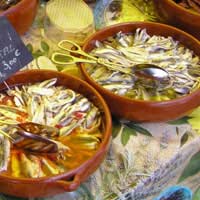Bagna Cauda

There can’t be many Italian dishes that translate to the great outdoors quite like a bagna cauda. There is no need for a range of pans or a hot oven here simply a heavy bottom pan, even better an ovenproof earthenware bowl and a portable source of heat such as a calor-gas burner.
The Italian verb bagnare translates as to bathe, and that is exactly the thinking behind the dish, which originates from the region of Piedmont: take some simple ingredients, mix them together and enjoy in the company of some crudite, or perhaps a little crusty bread, dipped in the hot sauce. In short the perfect snack when enjoying an autumnal day’s hiking in the misty hills of northern Italy. The less adventurous will find it equally satisfying as an appetiser in the comfort of their own home.
Break up the Bulb and Slice the Cloves
Depending on how many are in your group, or how ravenous they are, the following measures can be multiplied or reduced to order, but for the purposes of the recipe, six people will be assumed to be the number of hungry mouths to feed.Ingredients
- One bulb of garlic;
- 60 grams of butter,
- 250 millilitres of extra virgin olive oil,
- one jar of salted anchovies or the equivalent of about 15 fillets prewashed,
- freshly ground black pepper.
Method
- Pour the oil into whatever vessel is to be used to cook and keep the sauce hot. If using a pan, remember as mentioned above that it should be heavy bottomed, otherwise the sauce will catch on the bottom as it simmers, the garlic will burn and it will be good for nothing more than discarding.
- When the oil is hot, sauté the anchovy fillets and allow them to melt into the oil.
- Next break up the garlic bulb and slice the cloves. If preparing the dish outside, it is unlikely the garlic will be as well sliced as in the kitchen, but that won’t be a problem here: the accent is on the rustic.
A little Extra Luxury
- Briefly sauté the garlic in the oil and anchovy emulsion, then take the pan off the heat and drop in the butter, stirring it around the pan until it melts.
- If the butter is having difficulty breaking down, return the pan to the heat in order to accelerate the melting process.
- All that’s needed now is a few grinds of the pepper mill to taste and the bagna cauda is ready, although for a little extra luxury, some flat-leaf parsley would be welcome.
- Further deviation from the classic recipe could involve a squeeze of lemon, which would be particularly welcome on a cold day to inject a little sunshine into the proceedings.
- Keep the heat on the lowest setting so that the sauce can very gently bubble away. Such is the versatility of the bagna cauda that any vegetable will work well with it: there are the obvious candidates present on most plates of crudite such as carrots, celery and little red radishes.
- Little florets of raw broccoli or cauliflower would be other suitable candidates along with asparagus tips and peppers.


Re: The Structure of an Italian meal
When my grandpa returned from serving in the Navy during the Korean War, he disembarked in New York City, but lived in…
Re: Tomatoes and the Italian Culture
Susie - Your Question:Great advice on peeling and deseeding tomatoes. I was always anti because I believed the flavour was in…
Re: Tomatoes and the Italian Culture
Great advice on peeling and deseeding tomatoes. I was always anti because I believed the flavour was in the seeds and juice.…
Re: How to Make Traditional Sweet Ravioli
my question is. can I roll the dough out using my pasta machine or will the dough just get stuck
Re: Aperitivi, Digestivi and Other Mealtime Drinks
lips - Your Question:I would like to know what a formal diner in 1939 in Italy(Sicily) amongst the wealthy…
Re: Aperitivi, Digestivi and Other Mealtime Drinks
I would like to know what a formal dinner in 1939 in Italy(Sicily) amongst the wealthy was like- What was…
Re: Olive Oil Production
@Polly. This seems strange to find in the UK as regulations are quite stringent in terms of product descriptions. Here the informat
Re: Olive Oil Production
Have used what I believed to be virgin olive for years, well known brand, only to find that 70% of brands contain little olive oil and are…
Re: The Perfect Slow Cooker Ragu
@SaraBrown - a 1kg carton would be the best for this recipe. Add a bit at time though to ensure it's a consistency that you like.
Re: The Perfect Slow Cooker Ragu
Hi what size carton of passata please? I can buy anything from 200g to 1kg Thank you